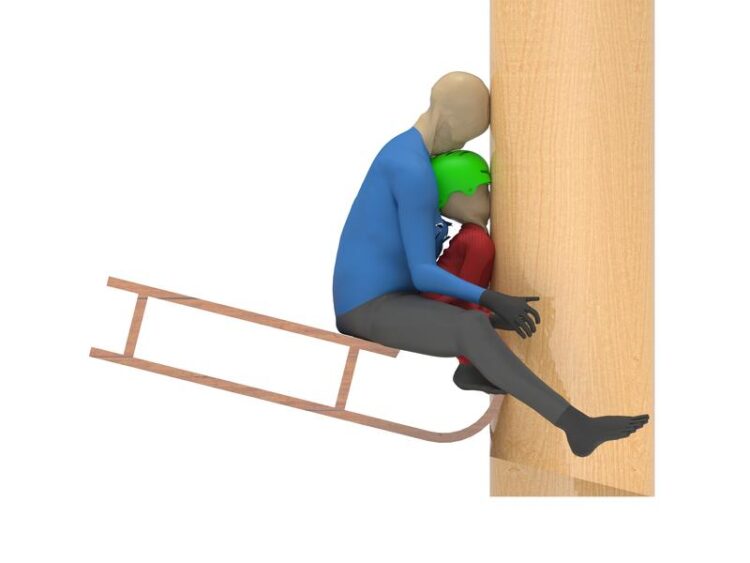Toboggan accident crash test: Without helmet, serious injuries even at low speeds

Computer-simulated crash tests at the Vehicle Safety Institute demonstrate the risk of injury when tobogganing.
© TU Graz – VSI
Crash tests are primarily known from traffic safety research. The Austrian Road Safety Board, together with TU Graz, has now investigated tobogganing accidents for the first time in a computer-simulated crash test. With alarming results: Without helmet, fatal head injuries are possible in collisions with trees, for example, even at low speeds. Wearing a helmet and the correct sitting position dramatically reduce the risk of injury for children while tobogganing.
More than 2,200 people are injured in toboggan accidents in Austria every year. On average, annually two accidents are fatal. In the 2019/20 toboggan season, as many as five people died. Collisions with stationary obstacles such as trees are among the most frequent causes of death. Researchers from the KFV (Austrian Road Safety Board) and the Vehicle Safety Institute at Graz University of Technology have now performed computer simulations using virtual human models to investigate which measures can reduce the risk of injury when tobogganing.
“Tobogganing is popular, year after year, many serious accidents occur. Detailed investigations, e.g. which speeds cause which injuries, are essential for prevention work. The results of our crash-simulations are alarming. Because the safety of a simple toboggan jaunt is deceptive, at least if you hit an almost rigid obstacle like a tree without wearing a helmet,” says KFV spokeswoman Dr. Johanna Trauner-Karner.
Safety factor helmet
The simulations clearly show that children tobogganing without helmets are at considerable risk of serious head injury from around 10 km/h. From a speed of about 20km/h, the risk of rib and femur fractures increases in addition to head injuries. “The research shows that a helmet significantly reduces the risk of head injury, regardless whether the person hits an obstacle head-on or sideways,” says Stefan Smit, a researcher at the Vehicle Safety Institute.
Two on the toboggan: the safest place for children is BEHIND the adult
The degree of injury in children is also influenced by their sitting position when they are tobogganing together with adults. If the child sits in the front of the adult, there is a significant risk of injury to the child’s thorax and thighs in addition to the risk of head injury, according to KFV and TU Graz: “In all of our simulation scenarios, the child was literally ‘pushed’ into the tree by the adult sitting behind. While impacting the tree is critical for the head, the thorax and thigh are subjected to high additional loads due to the weight of the adult and interaction with the sled.” The child is trapped between the tree and the adult. If, on the other hand, the child sits in the back, the head has more or less additional impact protection from the adult’s back, especially since the back is naturally softer than a tree or a lift column.
More details on the simulation method
The researchers used virtual models (finite element models) of the human body for their investigations. These were placed on a toboggan model in a typical tobogganing posture. The chosen accident scenario was hitting a tree, one of the most common causes of serious and fatal injury in tobogganing accidents. This accident situation was simulated with different impact speeds and different impact angles. To evaluate the protective effect of a helmet, simulations of a child riding alone were performed with and without a helmet. In the simulations in which the child used the toboggan together with an adult, the child sat once in the front and once in the back. Injury risk was assessed based on established injury criteria.
Conclusion of the experts: only go tobogganing with a helmet! Children sit in the back!
Wearing a helmet is especially important when tobogganing. The correct seating position – children behind the adult – greatly reduces the risk of injury when tobogganing.
This research is anchored in the Field of Expertise “Mobility & Production”, one of five strategic foci of Graz University of Technology.
Wissenschaftliche Ansprechpartner:
Contact TU Graz | Institute of Vehicle Safety
Dipl.-Ing. BSc Stefan SMIT
Tel.: +43 316 873 30327, stefan.smit@tugraz.at
Weitere Informationen:
https://www.tugraz.at/en/institutes/vsi/home/ (TU Graz | Vehicle Safety Institute)
https://www.kfv.at/ (Austrian Road Safety Board, German only)
(Video on the Research, German only)
Media Contact
All latest news from the category: Studies and Analyses
innovations-report maintains a wealth of in-depth studies and analyses from a variety of subject areas including business and finance, medicine and pharmacology, ecology and the environment, energy, communications and media, transportation, work, family and leisure.
Newest articles

Superradiant atoms could push the boundaries of how precisely time can be measured
Superradiant atoms can help us measure time more precisely than ever. In a new study, researchers from the University of Copenhagen present a new method for measuring the time interval,…

Ion thermoelectric conversion devices for near room temperature
The electrode sheet of the thermoelectric device consists of ionic hydrogel, which is sandwiched between the electrodes to form, and the Prussian blue on the electrode undergoes a redox reaction…

Zap Energy achieves 37-million-degree temperatures in a compact device
New publication reports record electron temperatures for a small-scale, sheared-flow-stabilized Z-pinch fusion device. In the nine decades since humans first produced fusion reactions, only a few fusion technologies have demonstrated…





















